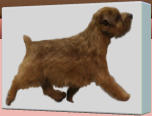

Breeders Corner

Kafka said, "All knowledge, the
totality of all questions and
answers, is contained in the dog."

Please submit your article,
publication or hyperlink to an
article to Judi Hartell.
DataDawg@Austin.rr.com
Submissions

Quote



The Bluebonnet Norfolk Terrier Club does not recommend,
guarantee, endorse, nor rate these recommendations or
contributors, their kennel or their stock. The purpose of this section
is to share the knowledge and experience of breeders who have vast
experience in whelping and raising puppies. The tips and tricks
below are intended to augment qualified veterinarian care, not as a
substitute for qualified veterinarian care of the dam and puppies.





Continuing Dr. Bell's Relative Risk Analysis theory, statistically. The offspring of an
affected dog has a 100 percent chance of being a carrier.
Continuing Dr. Bell's Relative Risk Analysis theory, statistically • The clinically normal full
sibling of an affected dog has a 67 percent chance of being a carrier.
Jerold S. Bell, D.V.M., clinical assistant professor of genetics at Tufts University School of
Veterinary Medicine, Bell says • The parent of an affected dog has a 100 percent chance
of being a carrier.
Jerold S. Bell, D.V.M., says: If a breeding female has X amount of risk of being a carrier,
breeding it to a low-risk mate can cut the carrier risk up to 1/2 X in the offspring, he says.
However, if you breed three offspring, then you have added three times 1/2 X into the
population. With relative-risk assessment, you have to combine the analysis with
replacing the higher-risk parent and limiting the number of reproducing offspring
For a defective recessive gene to be passed on, there must be a carrier parent in each
generation. However, unless the ancestral carriers have produced affected offspring or
were the offspring of affected dogs, they cannot be identified. If four generations
separate the carrier sire and an obligate carrier ancestor, then it is possible the shared
ancestors between them could be carriers.
1 More factors for a Relative Risk Analysis Pedigree to be effective include:
There must be an established open health registry database, such as the American
Kennel Club Canine Health Foundation�s Canine Health Information Center (CHIC), that
records the confirmed affected and carrier status of dogs.
Important factors for a Relative Risk Analysis Pedigree to be effective include:
* The mode of inheritance must be proven to be recessive
* The pedigree information must be accurate and verifiable

Phenotype & Genotype. How a dog looks on the outside does not always predict what
genes he is carrying and what he will produce.
Example: A dog inheriting the gene pair Tt from his parents will have ticking, but because
he "carries" the gene t for non-ticking, he is capable of producing dogs with non-ticking
when bred to a bitch carrying the Tt or tt gene pair. The non-ticking would occur in any
puppy that by chance happens to inherit his sire's t gene and a t gene from the dam.


- Behavior
- Honor Roll
- Living With Norfolk Terriers
- Fun With Your Norfolk
- Tip Of The Week
- Publications
- Therapy and Service Dogs
- Health & Nutrition
- Competition


- Books
- Clubs
- Collectibles, Gifts & Fun Activities
- Companion Animal Recovery
- Dog Show Superintendents
- Genetics
- Health Related Sites
- Canine Health Links
- Vaccination Protocols
- Animal Health Trust
- Online Mendelian Inheritance In Animals
- Univ. Of Cambridge Vet. School
- Canine Inherited Disorders Database
- All Creatures Veterinary Hospital
- A First Aid Kit
- Veterinary Pet Insurance
- AKC Pet Health Plan
- Cornell Univ. College of Vet. Medicine
- More Health Related Sites
- Independent Sites
- Pet Travel
- Training Your Puppy
- Publications


- Breeding Tips
- Breeding Tips Page One
- Breeding Tips Page Two
- Breeding Tips Page Three
- Breeding Tips Page Four
- Breeding Tips Page Five
- Breeding Tips Page Six
- Virus &The Pregnant Bitch
- Dog Neutering Video
- Vaccinations & The Pregnant Bitch
- Incontinence In The Pregnant Bitch
- Flagyl & The Pregnant Bitch
- Canine Reproduction
- Frozen vs Chilled Semen
- Modern Breeding Management
- Dialogue On Rasberry Leaves
- Monitoring Pregnancy
- Uses For Vaginal Cultures
- OFA & The Pregnant Bitch
- Breeding Tips Page Seven
- Breeding Tips Page Eight
- Breeding Tips Page Nine
- Breeding Tips Page Ten
- Breeding Tips Page Eleven
- Breeding Tips Page Twelve
- Breeding Tips Page Thirteen
- Breeding Tips Page Fourteen
- Genetics And Inheritance
- Rescue









